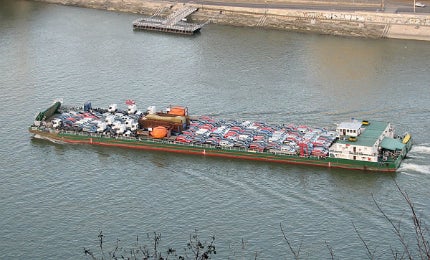
Eastern Shipbuilding Group, a ship-builder based in Florida, unveiled a new inland towboat design named Thunderbolt, in February 2015.
The new boat is designed for operation in inland waterways, and will offer increased efficiency, performance, manoeuvrability and crew comfort.
The idea to develop a new towboat based on thruster propulsion systems was conceptualised at the International WorkBoat Show, held at New Orleans, Louisiana, in 2013.
Eastern Shipbuilding and Verhaar Omega teamed up to create a new towboat design with thruster propulsion, which is more efficient than conventional nozzle propeller propulsion systems .
Eastern Shipbuilding also worked with engineering firm Gilbert Associates for more than a year to develop the new, hybrid diesel-electric design for the US inland waterways market.
Thunderbolt design and dimensions
The Thunderbolt was designed in accordance with ABS Class 2014 rules for building and classing steel vessels on rivers and intracoastal waterways, as well as proposed US Coast Guard 46CFR towing vessel rules and IEEE 45 2002 standards.
Terminal and escort tugs designed and engineered by Canadian naval architects and marine engineering company Robert Allan (RAL)
The towboat will have a length of 36.57m, beam of 10.97m, hull depth of 3.42m in the centre, and hull depth of 4.03m at the head log. The design waterline length (DWL) of the boat will be 2.98m. The vessel will accommodate onboard crew in 10 berths.
The vessel will feature three types of tank to store fuel, freshwater and potable water. The total fuel tank capacity is approximately 152.6m3, with the freshwater tank capacity being 143.9m3 and the potable water tank capacity being 41.3m3.
Propulsion and power for Thunderbolt
The propulsion system integrates Verhaar Omega 690V AC electric V-POD propulsion units, and twin Omega Propulsion AFE/VFD Drives. The propulsion unit produces thrust of 94,350lb.
The 360º rotatable twin V-Pods, which can rotate 180º in approximately 14 seconds, will enable the vessel to offer enhanced steering manoeuvrability and precision, as well as braking capability. The V-Pods are fitted with VFD-Reversing Induction motors, which produce 1,770HP each.
The vessel is also equipped with three 990kW Cummins Mid-South-AVK DSG74 generators. The generator package also includes three identical Cummins Mid-South-QSK38-DM Tier 3 diesel-electric generator engines, each capable of generating 1,400hp of power. The engines also power a Cummins AVK DSG-74 water-cooled generator providing 990kW at 1,800rpm.
The power management system (PMS), to be supplied by Beier Radio, will automatically control the operation of generators. It will autonomously shut-down any generator if less power is required by the vessel, and will also auto-start generators on peak demand.
The electrical and propulsion unit on the vessel will produce less noise and vibration, while the automated power management will ensure reduced operational costs, system redundancy, increased crew comfort, safety, and less crew fatigue.
Thunderbolt performance and manoeuvrability
Thunderbolt will consume 92 gallons of fuel per hour, or 2,136 gallons a day, to generate 37,740lb of thrust.
The power consumption can be increased to 138 gallons of fuel per hour, or 3,312 gallons per day, to produce 65,100lb of thrust. The fuel consumption will be 194 gallons per hour, or 4,656 gallons per day, when three generators are online to produce 94,350lb of thrust.
The Thunderbolt is designed to push a six-pack of 30,000 barrel tank barges upstream in a high-water current, which requires full power to achieve towing speed. Similarly, it will require less power while transiting downstream. The PMS will automatically shutdown the unnecessary power plants, thus helping to conserve fuel.
When the tow is at the port, the vessel can be propelled by auxiliary power supplied by a harbour generator while shutting down the main diesel-electric power plants.
The V-Pods, compared to conventional Z-drives, are of less weight and hence achieve better efficiency at the right-angle gear drive. Further, the entire underwater unit can be removed without dry-docking the vessel, in case of damage being caused to the V-Pods.






